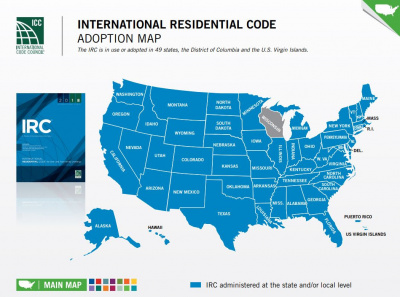How the IRC and IBC Codes Impact Construction Projects
The following content is part of SBCA’s Construction Industry Workflow Initiative, which is exploring how the construction industry currently functions and the role component manufacturers play within that structure. Your feedback is encouraged to help us complete this project, email info@sbcacomponents.com to provide your input.

The first test for any new construction project is determining the building codes that will apply to it. This article will briefly outline how every project falls into one of two model codes based on the features of the structure. Location is the initial criteria, as each state adopts into law various versions of building codes determined by individual state legislatures. From there each jurisdiction within that state, whether it is an incorporated city or non-incorporated area within a county, parish or borough, determines specific portions of the codes it adopts and enforces. While many codes exist for governing various aspects of a building related to construction, fire service, MEP systems, energy, maintenance, etc.; two model codes exist for use in new construction: the International Residential Code (IRC) and International Building Code (IBC). For a complete listing of codes and their adoption by state, visit the Code Adoption Maps.
The IRC is the prevailing code for what are generally considered residential structures and is in use or adopted in 49 states, the District of Columbia and the U.S. Virgin Islands. The one state it is not adopted is Wisconsin, which has its own building code but is working toward IRC adoption. Within new construction, the IRC’s scope includes “detached one- and two-family dwellings and townhouses not more than three stories above grade plane in height with a separate means of egress, and their accessory structures not more than three stories above grade plane in height.” In other words, single-family homes and duplex type structures three stories or less are covered under the IRC. A limited number of additional structures per R101.2 Scope are included in the IRC with the use of residential fire sprinkler systems such as owner-occupied lodging houses or care facilities with five or fewer people receiving custodial or medical care.
The IBC covers construction of structures not contained within the IRC, and is in use or adopted in all 50 states, the District of Columbia, the U.S. Virgin Islands, Guam and the Northern Marianas Islands. The IBC covers commercial buildings, multi-family apartment complexes and other public structures like schools and churches. Like the IRC, its intent is to establish minimum requirements to provide a reasonable level of safety, public health and general welfare through structural strength, means of egress, stability, adequate light and ventilation, and protection of life and property.
Accessing the IRC & IBC Codes
The IRC & IBC Codes are available online for free, in read only formats in multiple places. Review original, unaltered versions of the IRC, IBC and other I-Codes or view specific versions adopted by a state and jurisdiction.
The IRC, by its nature, is generally considered a prescriptive code. This means that the code lays out direction for materials and installation methods of the structures under its jurisdiction. While a number of techniques and items are covered in the IRC, it does leave room for certain items to be used under a performance-based (or engineered) use described as “alternative materials and methods” as illustrated in this article. More specifically, the IRC covers certain materials in a prescriptive way within certain limits. Once those limits are met or exceeded, engineering applications are typically required to address those materials, which can then be submitted to building officials for review and approval under the IBC. While requiring additional engineering for a specific material or its installation, the use of engineering means does not disqualify the remainder of the structure from the IRC code. These provisions and the associated limits will be addressed in a subsequent article in greater detail.
For additional information, please reference these resources:


